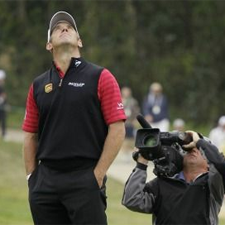Sometimes good things happen when objects fall from trees–for example: Sir Isaac Newton would develop the Universal Laws of Gravitation when an apple tumbled from its branch while he was under it’s tree. Conversely, bad things can happen when objects DON’T fall from trees–Just ask Phil Mickelson or Lee Westwood about the U.S. Open Championship that was held at Olympic Club in San Francisco a couple of weeks ago.
Phil’s opening tee shot entered a tree and presumably never emerged, and Lee, while in contention during the final round, could not find his ball that disappeared into a tree on the 5th hole. Both players, along with massive galleries, searched in vain for their golf balls for the allotted 5 minutes. At the end of each of their five-minute searches, their ball was rendered lost under Rule 27-1. Both players incurred a stroke and distance penalty and because they both played from the teeing ground were required to go back to this spot and put another ball into play.
Many viewers, especially in Lee’s scenario, posed the question, “How come he couldn’t have just declared the ball unplayable and dropped the ball under the tree?” There are two main reasons why this would not be acceptable. The first reason is because it is only presumed that their golf balls were lodged up in the tree–it was not known for certain. The balls could have hit the tree and bounced to a different location, maybe even ricocheted out of the tree into some very heavy rough where no one could see the ball.
Secondly, the players could not drop a new ball under the tree because they had no reference point. Rule 28 (Ball Unplayable) does allow you to declare your ball unplayable without finding it, however, your only option is stroke and distance. The other two options under this Rule require you to know where the location of your golf ball is as this will be your reference point in taking relief. In the absence of finding the ball, you cannot accurately determine where to drop a new ball.
Remember, finding a ball doesn’t mean you must have it in your hand. If you can identify it by seeing it in the tree and know that is your ball, that would satisfy the requirement. Lee tried to do this by borrowing a pair of binoculars to look into the tree to see if he could find and identify his ball. It turns out he could not find it and back to the tee he went under stroke and distance.
Interestingly, another Lee had a similar situation at the 1998 U.S. Open at Olympic. Lee Janzen hit his ball in the same exact tree as Lee Westwood did, however he had a different fate. Mr. Janzen started to go back to the tee as he conceded that his ball was lost in the tree, but before he could put another ball into play, and also before his five minute time period to search for the ball was up, it miraculously fell out of the tree. Since his ball was found within the five minutes he was permitted to play his original ball and went on to win his second U.S. Open title.
Lee Janzen would call it miraculous, but Sir Isaac Newton would simply call it the Laws of Gravitation.


